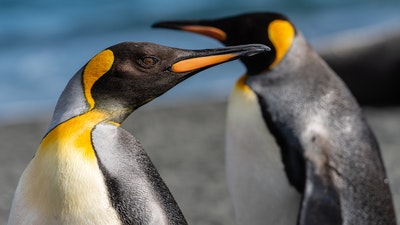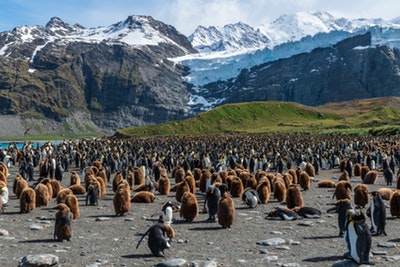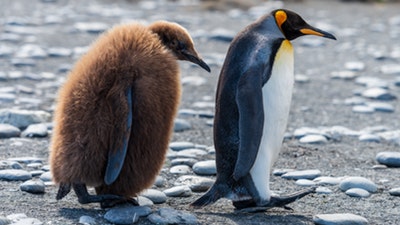Most colourful award for an Antarctic penguin goes to…

With their bright orange/gold colouring on their heads and neck the King penguin is the most colourful of all the Antarctic penguins but they don’t live on the Antarctic mainland. They live only on the sub-Antarctic Islands, mainly Crozet Island, Kerguelen Island, Heard Island, Prince Edward Island, South Georgia and Macquarie Island. The world’s largest colony of King penguins is on South Georgia.
History
The King penguin was first discovered in the early 18th century and at the time were thought to be the largest living penguin until the British Museum, in 1844, distinguished them from the larger Emperor penguin.
During the 19th through to the early 20th centuries, after they had almost destroyed the entire fur seal population, the sealing industry turned their attention to king penguins as a source of oil and had a devastating impact on their numbers. After the end of the sealing industry populations of King penguins have been increasing.
King penguins tend to form very large colonies with the largest populations found at South Georgia and Crozet islands, situated on level ground along the beaches and valleys there. Colonies can consist of several hundred thousand breeding pairs.

Breeding and diet
Unlike most other penguin species, King penguins don’t make a nest. They lay an egg and carry it under their brood patch on their feet. The brood patch is a flap of abdominal skin and keeps the egg warm. The egg is shared between parents for the average 55 day incubation period. While one parent looks after the egg, the other heads out to sea in search of food.
The hatched chicks will be kept under the brood patch for another 30-40 days after which they can fend for themselves, at least as far as temperature goes, but they still need the food that the parents provide. Breeding happens in two waves, early and late, so there are chicks around for most of the year. This is unusual compared to other penguins who only have one breeding season.
King penguins have a fairly specialised diet and unlike many other penguins, krill (a type of shrimp) does not figure in their diet. They mainly eat lantern fish (myctophids), mainly in the breeding season and during the winter they increase their consumption of squid. Their main predators at sea are the usual suspects, leopard seals and killer whales. In their colonies, skuas, sheathbills and giant petrels are the main predators of eggs and young birds. In the Falkland Islands (Malvinas), turkey vultures and caracaras (a type of falcon) also feed on eggs and chicks.

